![]()
![]()
![]()
Use LEFT and RIGHT arrow keys to navigate between flashcards;
Use UP and DOWN arrow keys to flip the card;
H to show hint;
A reads text to speech;
34 Cards in this Set
- Front
- Back
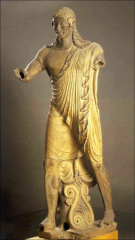
|
Apollo, ca. 510-500 BCE
Clothed Terracotta Rooftop animated Archaic smile |
|
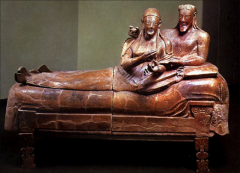
|
Cerveti Sarcophagus, ca. 520 BCE, terracotta.
Etruscan had their cremated remains placed in sarcophagi. There are no comparable works in Greek art that show a man and woman reclining together. “Talking” with their hands. |
|
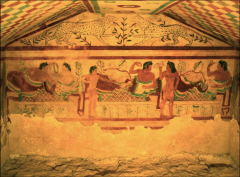
|
Tomb of the Leopards, Tarquinia, Italy, ca. 480-470 BCE.
Some tombs included wall paintings of celebrating life and its pleasures. Women are shown with men. Also note hand gestures. |
|
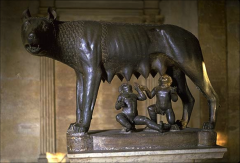
|
Capitoline Wolf, bronze, ca. 500-480 BCE
This defiant image is the emblem of Rome to this day. The infants were added in the 15th century. |
|
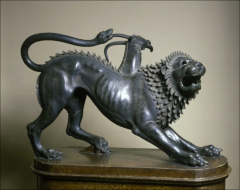
|
Chimera of Arezzo, bronze, fourth century BCE.
The chimera was a composite monster of Greek invention |
|
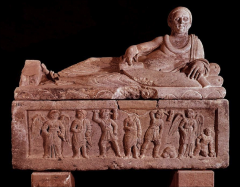
|
Sarcophagus of Lars Pulena, stone, early 2nd century BCE.
The scroll lists his accomplishments. The frieze depicts him between two charuns (Etruscan death demons). Charuns tormented those underworld. Sometimes depicted with wings. Compare the mood to earlier Cerveteri sarcophagus. |
|
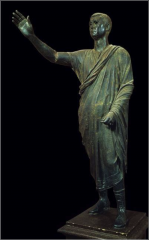
|
Aule Metele, bronze, early 1st century BCE.
Another example of Etruscan skill in bronze casting. He is shown in the clothing of a Roman magistrate in the act of addressing an assembly. Etruscans became Romans and Etruscan art became Roman art. |
|
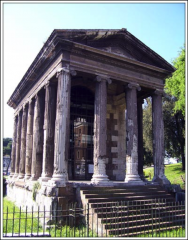
|
Temple of Portunus, Rome, ca. 75 BCE
The temple combines Etruscan and Greek elements to create a distinctive Roman design. High platform accessible only at the front Ionic columns and frieze Stone overlaid with stucco to imitate Greek marble Engaged Ionic half columns pseudoperipteral |
|
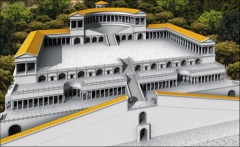
|
Sanctuary of Fortuna Primigenia (restored)Palestrina, Italy, late 2nd century BCE The use of concrete barrel vaults allowed the Romans to
Transform the entire hillside, subjecting nature itself to human will and rational order. |
|
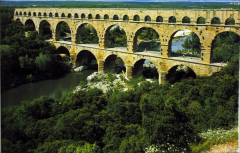
|
Pont-du-Gard, Nimes France, ca. 16 BCE
100 gallons a day per person from 30 miles away. Rome had 11 aqueducts |
|
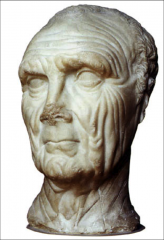
|
Although familiar with idealized Classical portraits, early Romans rejected them in favor of brutal realism callled veristic (superrealist ) portraits. In general, only elders held any power in the Republic.
Romans believed that the head alone was enough to constitute a true portrait (portrait bust). The busts served the important function of a visual representation of a family’s genealogy. The busts (imagines) were kept and proudly paraded at the funerals of family members. Verism indicated virtue Serious Experienced Strength of character Loyalty to state and family |
|

|
Roman patrician with busts of his ancestors, late 1st century BCE. Marble.
|
|
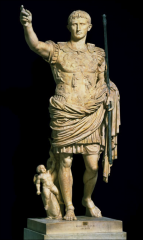
|
Portrait of Augustus as general
Early first century marble (possible copy of bronze original ca. 20 BCE.) As the leader of a vast and diverse empire, Augustus understood the importance of using art to create public images that projected his power and authority. Based on the Doryphoros Gesture of command Larger than life (6’8”) Youthful although 40 Lack of verism Venus’s son Cupid marks his divine familial descent, thus he has the approval of the gods. |
|

|
Ara Pacis Augustae, Rome, 13-9 BCE (Altar of Augustan Peace)
Another example of Augustus’s use of art as imperial propaganda. Commissioned by the senate, the altar celebrates Augustus’s role as a leader who brought Rome the blessings of peace and prosperity. |
|
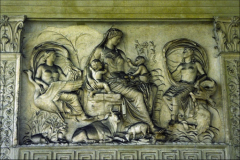
|
Female personification, Ara Pacis
Mother Earth (Tellus Mater)nurtures the Roman people represented by two chubby babies. She is surrounded by flowering plants and peaceful animals, symbols of the fruits of the Pax Romana. Land wind and sea wind reminder of Rome’s dominion. |
|
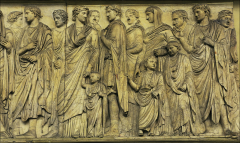
|
Procession of the imperial family, detail, Ara Pacis
Alarmed by the low birthrate among the nobility, the portrayal of actual noble families provided an example to be emulated. Children had never before appeared on a Greek or Roman state monument. High to low provides depth. |
|
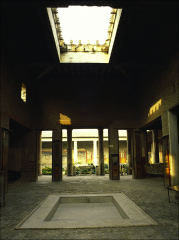
|
Atrium of the House of the Vetti, Pompeii
Central atrium Impluvium collected rainwater Cubicula (bedroom) House of The Vettii, Peristyle garden. |
|
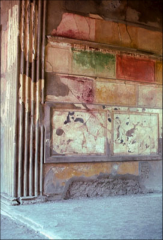
|
Almost all surviving Roman wall paintings come from Pompeii and Herculaneum. They are true frescos.
First Style- imitates marble. Greek influenced First Style is also referred to as masonry style. |
|
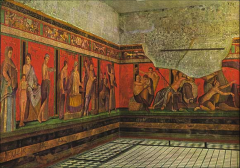
|
Villa of the Mysteries, Pompeii. Great Frieze of the Dionysiac Mysteries. Second Style –illusion of the 3rd dimension. The lower section(dado) is painted to look like marble. The action takes place on a shallow “stage” along the top of the dado.
|
|
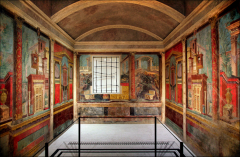
|
Villa of Publius Fannius Synistor, Boscoreale, ca. 50-40 BCE.
Boscoreale was a town just outside Pompeii. This villa was discovered in 1900 and sold off to the highest bidder. This reconstructed bedroom is in the Met. |
|

|
Second Style
The Romans knew how to use perspective to create the illusion of depth. The Second Style is sometimes referred to as architectural style. These paintings were an attempt to provide a sense if space to the small, windowless rooms. |
|
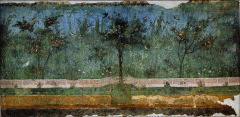
|
Gardenscape, Villa of Livia, Primaporta ca. 30-20BCE
Atmospheric (aerial)perspective creates the illusion of depth |
|
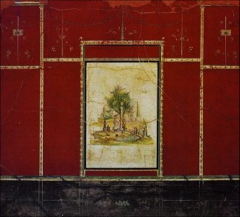
|
Third style included monochromatic walls and intricate details. Illusionism was rejected in favor of surface ornamentation. Also called the ornate style. Very symmetrical
|
|
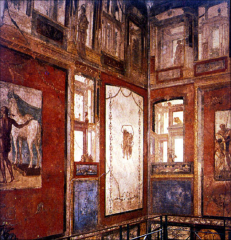
|
House of the Vettii, Pompeii. Fourth style included parts of Third style plus “windows” revealing irrational architectural vistas and narrative painting.
Compositions were often crowded and confused. Sometimes referred to as the intricate style. |
|
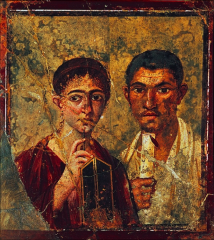
|
Portrait of a husband and wife, Pompeii, ca. 70-79 CE
Attributes (scroll, stylus) suggest education. The figures are individual portraits. |
|
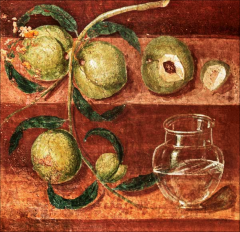
|
Still life with peaches, detail, Fourth Style, Herculaneum, ca. 62-79 CE.
Like the cities of Pompeii and Herculaneum, still life painting would be forgotten for over a thousand years. |
|
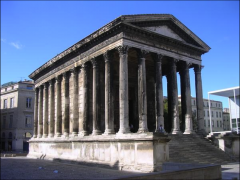
|
Maison Carree, Nimes, France, ca. 1-10 CE. Psuedoperipteral, portico
|
|
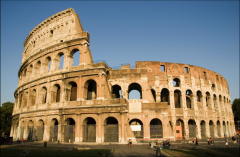
|
The Coliseum (Flavian Amphitheater) Rome, ca. 70-80 CE
Use of concrete barrel vaults Roman arch and Greek orders Hierarchy of orders From the ground up: Tuscan, Ionic, Corinthian engaged columns. Corinthian pilasters |
|
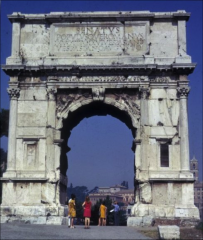
|
Arch of Titus, Rome, after 81 CE.
A second-century visitor would have see more than thirty marble triumphal arches. These freestanding monuments commemorated notable imperial triumphs. This arch commemorates Titus’s conquest of Jerusalem. The arch is noteworthy for two relief panels located on the inside walls. |
|

|
Roman soldiers are carrying a sacred seven-branched candelabrum taken from the Temple of Jerusalem.
|
|
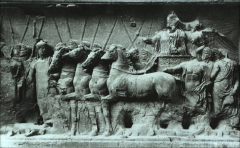
|
Titus in a chariot accompanied by statues of divinities representing the imperial virtues of victory, honor, and valor. This was the first time mortals and immortals interacted, but it soon became a staple of Roman narrative relief sculpture.
|
|
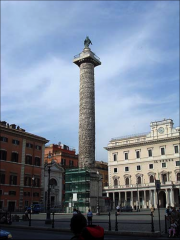
|
Column of Trajan, Rome, 112 CE
Trajan commemorated his victory over the Dacians by erecting a 125 foot column. A statue of the emperor once adorned the top of the column, and his cremated remains were placed inside a golden urn at the base. A low relief frieze 625 feet long winds around the column like an enormous scroll. Trajan appears in 1/3 of the 150 episodes, conducting sacrifices, addressing troops and supervising the campaign. In 1587, Pope Sixtus V replaced the emperor’s statue with one of Saint Peter.Romans crossing the Danube and building a fort, from the Column of Trajan. Each band is approx. 36” tall. |
|
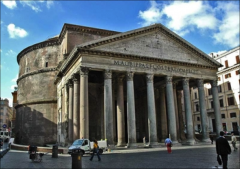
|
Pantheon, Rome, 118-125 CE
Emperor Hadrian erected this temple to all the gods (pan theoi). The Pantheon revolutionized architectural history by combining a portico with a domed rotunda (dome and drum). The oculus is 29 feet wide. A 142-foot-high concrete dome covered a 142-foot-wide spherical floor. A Roman standing at the center of the perfectly proportional space could understand that the dome was meant to symbolize the vault of the heavens protecting the orb of the earth. A circular opening in the center of the dome (oculus) allowed the sun to illuminate the statues of gods and goddesses. The sun’s rays symbolized Jupiter’s all-seeing eye. In 609 CE, Pope Boniface IV dedicated the Pantheon as the church of Saint Mary of the Martyrs, thus ensuring its survival through the Middle Ages. |
|
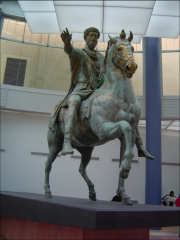
|
Equestrian Statue of Marcus Aurelius, Rome, ca. 175 CE The larger-than-life statue portrays the emperor sitting calmly on a Spanish war steed. A defeated enemy may have cowered beneath the right hoof while Aurelius extends his hand in clemency. He needs no weapons; his will alone is sufficient.
The only reason this statue survived while almost all the other roman bronzes were melted down is because early Christian thought it depicted Constantine, considered the first Christian emperor. |

